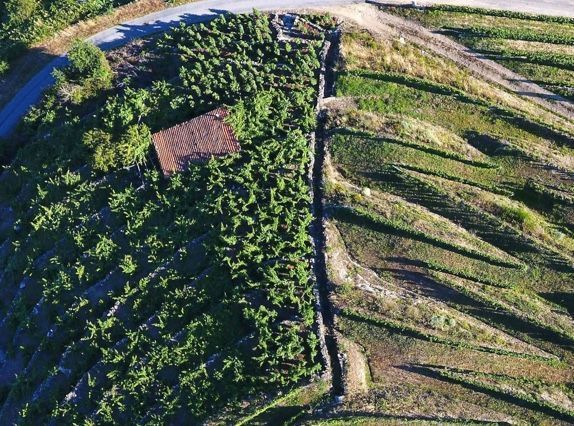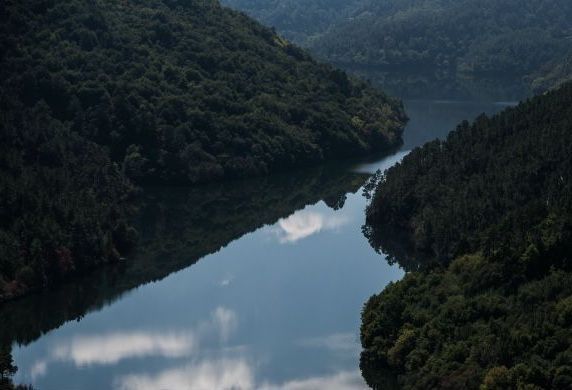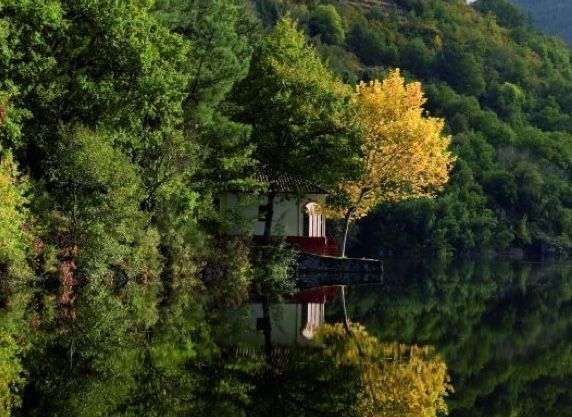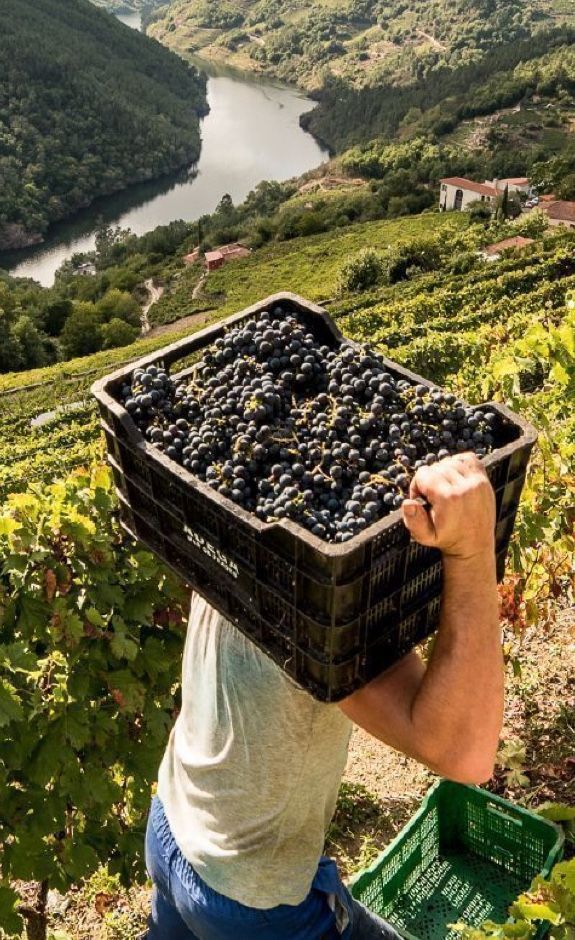
Riberia Sacra is located between the south of the province of Lugo and the north of the province of Ourense, to the shelter of the rivers Miño and Sil. In this area in the interior of Galicia, the soil of alluvial character and of granite and slate origin forms very hilly banks of the River, eroded over the millennia.
The ecoclimate generated in these areas, traditionally of ocean type, acquires a more Mediterranean character, the most optimal for a good maturation in our latitude.
More than two thousand years ago the Romans arrived in Galicia and they implanted their culture. One of their most important agricultural activity was the cultivation of vine and the elaboration of wine, and so they sought the best areas to cultivate them. Most of the muras (stone walls round the terraces) and terraces that still predominate in landscape are theirs. Wine obtained in this area was well known, and it is said that it was taken to Caesar himself in Rome.
Hundreds of years later, the monks found here an isolated place, with fertile soils, a pleasant climate and abundant water to settle and build their monasteries. Skilful in the crops, they brought the vines to many areas of our geography and spread the consumption of wine.
In the last centuries, viticulture had a subsistence character, considering wine as a further food, and even sharing the land with other crops. Finally, the successive hereditary partitions came to determine this smallholdings so characteristic of our idiosyncrasy as of our landscape.

Adegas Moure was one of the wineries that were grouped from the beginning to create the Ribeira Sacra denomination of origin (D.O.), with the aim of promoting and protecting the wines and vineyards of this area.
Because of the difficulty of cultivation that it represents, it is called "heroic viticulture", forming part of the CERVIM, association that generates value to mountain viticulture.
This D.O. which floats between the river Miño and the Sil, houses a variety of ecological niches. One of the most relevant characteristics of the area is the cultivation in terraces (muras) due to the strong slope of these canyons.
In the D.O. Ribeira Sacra , the sub-area in which we are located is the Ribeiras do Miño, specifically in the parish of A Cova, Lugar de Cuñas, although we also have vineyards in different areas of production within the D.O. The soils and the mesoclimate of this area vary greatly throughout the different areas, and even at the level of plots, hence the importance of the type of soil, slope, altitude and orientation.
The climate data yields an average temperature of 14 º and a rainfall of 900 mm a year in the banks of the Miño (270 mm from April to September), in addition to light winds. The relative humidity is around 70% and the hours of sun around 180 monthly. These values are currently being affected as a result of the process of climate change process we are suffering. In the last few years we are having higher temperatures, a drier climate, and a longer summer. We are very concerned about this serious problem, and we are working to minimize our carbon footprint.
For these reasons, our commitment to nature is to form a single tandem, which leads us to a sustainable agriculture, integrated into the landscape, and in which both parts would be benefited: The environment, with a greater diversity of species and habitats, and us with a large vineyard and a wine of height.


In Abadía da Cova, the vineyard acts as a backbone of some products with unique characteristics. The terroir acquires an essential dimension, because it does not depend exclusively on the climate and the type of soil, but on the conditions of each slope, on its orientation, sunstroke and humidity in its different parts.
In these slopes we are looking for South or South-West directions, an altitude appropriate for a correct temperature, the optimal soil and sunlight optimal... and the river, as a determining factor in all of them. It is the search for the place that best expresses the characteristics of each of our varieties, this to grow them only on the ground that best suit. The sum of these factors will eventually clarify the mystery... vintage after vintage.
The heroic viticulture is the only type of viticulture possible, because the best conditions for the vineyard are in the slopes of the river, with inclinations that reach 70%. All the works are done meticulously and manually by our viticulture team.
Nowadays, we are deepening the knowledge of the Biodynamic principles, rehearsing in our experimental vineyards to be able to benefit from this knowledge and improve the conditions of cultivation of our vines.
We have several meteorological stations in the own vineyards, which allow us to measure the atmospheric and soil values of our plots and to establish action protocols that allow us to get the best performance from our vines, as well as prevent possible infections by undesirable fungi.
The principles of ecology, respect and commitment to the environment, as well as the preservation of this natural area, have always been fundamental to our company.
In our vineyards there are two types of soils. In the areas of Ribeira de Miño and Amandi, the soils are mainly granite, with veins of slate and shale. In the part of Montefurado and Quiroga they are slate of sand and clay.



Constitutes vines in "vase" or vertical system, which are pruned to guyot simple or double, limiting the number of buds on the basis of vigour and health of each strain. This conduction system represents about 5.5 hectares of vineyard, divided into numerous small plots. It houses the oldest vines of property, which we are trying to preserve with extreme care in its growing conditions.
We use it in the two farms of our own Albariño, also of the oldest. It represents about 3.5 hectares of vineyards, and allows us to control the vigour of these restless vines, as well as to take advantage of 100% of the solar energy because it is a continuous surface system.
In the most recent vineyards, we are cultivating in espalier. The vines are guided by double cord, single cord or in vertical system with Guyot pruning. There are currently some 9.5 hectares of vineyards in espalier.
The aim is to achieve a greater depth and originality in the different types of wine.
We cultivate our grapes in several areas within the D.O. As a main area we find the Ribeiras of Miño, however, we also produce grapes in Amandi, Montefurado and Quiroga. This differentiation of plots gives us significant features, and great contrasts in the parameters of the grapes. The aim is to achieve a greater depth and originality in the different types of wine.
Our winery produces most of the grapes used in our wines. However, there are other interesting plots and great vine-grower who give us grapes which we could not have otherwise access. We only buy grapes from trusted vine-growers, with whom we have been working more than 20 years as average. We classify the plots and allocate that grape to the wines that we believe appropriate. We work side by side to make the vineyard been worked in the most optimal and respectful way and with our own quality criteria. We guide and support each other with each wine-grower during the whole process, until the best result is obtained in each case.
We invite you to know an unique place guided by Abadía da Cova.
